Sep . 09, 2024 23:59 Back to list
toughened glass and laminated glass
Toughened Glass and Laminated Glass An Overview
In the realm of modern architecture and design, the choice of glass plays a crucial role in ensuring safety, energy efficiency, and aesthetic appeal. Two popular types of safety glass used in construction and automotive applications are toughened glass and laminated glass. Each has distinct properties and uses that cater to various needs.
Toughened Glass
Toughened glass, also known as tempered glass, is made through a process of extreme heating and rapid cooling. This treatment increases its strength compared to regular glass, making it approximately five to seven times stronger. It can withstand significant stress and impact, which makes it an excellent choice for applications such as shower doors, glass facades, and table tops.
One of the main advantages of toughened glass is its safety feature. In the event of breakage, it shatters into small, blunt pieces, minimizing the risk of injury. This property is particularly valuable in environments with high foot traffic or where children are present. Additionally, toughened glass retains clarity and does not warp, making it ideal for applications where visibility and aesthetics are crucial.
Laminated Glass
toughened glass and laminated glass

Laminated glass, on the other hand, consists of two or more layers of glass bonded together with an interlayer, usually made of polyvinyl butyral (PVB). This construction not only enhances its strength but also provides additional safety. In the event of a break, the interlayer holds the shards together, preventing them from scattering and reducing the risk of injury. This feature makes laminated glass a popular choice for car windshields, skylights, and safety glass in buildings.
Moreover, laminated glass offers improved sound insulation and UV protection, making it an excellent option for urban settings where noise pollution and harmful sun rays are concerns. It also contributes to energy efficiency by reducing heat transfer, which can lead to lower heating and cooling costs in buildings.
Conclusion
Both toughened and laminated glass serve vital roles in enhancing safety and design in various applications. Toughened glass shines in its strength and shattered safety, making it suitable for high-impact areas. Laminated glass offers an unprecedented combination of strength, sound insulation, and UV protection, making it versatile for both residential and commercial use.
Choosing between these two types of glass ultimately depends on the specific requirements of a project, including safety, aesthetics, and functional performance. As technology continues to evolve, both toughened and laminated glass will remain integral components in the construction and design sectors.
-
Sustainable Practices in a Modern Coated Glass Factory
NewsAug.07,2025
-
Insulated Glass Unit Installation Best Practices and Tips
NewsAug.07,2025
-
Frosted Glass Types and Custom Solutions for Sale
NewsAug.07,2025
-
Current Clear Float Glass Price Trends in Global Markets
NewsAug.07,2025
-
Comparing Different Types of Laminated Glass Performance
NewsAug.07,2025
-
Best Anti Fog Bathroom Mirror Solutions for Humid Climates
NewsAug.07,2025
Related PRODUCTS













